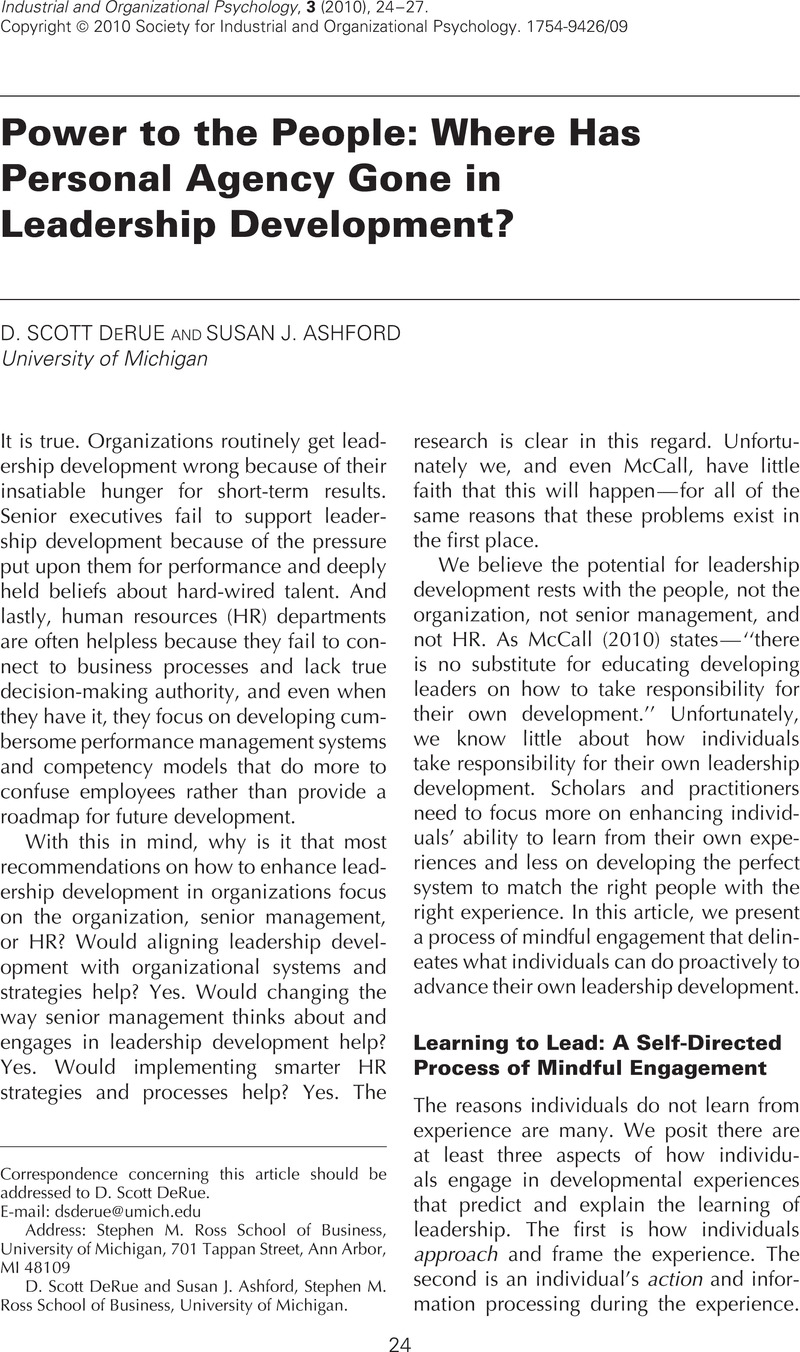Crossref Citations
This article has been cited by the following publications. This list is generated based on data provided by Crossref.
McCall, Morgan W.
2010.
Peeling the Onion: Getting Inside Experience-Based Leadership Development.
Industrial and Organizational Psychology,
Vol. 3,
Issue. 1,
p.
61.
Petriglieri, Gianpiero
2011.
Identity Workspaces for Leadership Development.
SSRN Electronic Journal,
Petriglieri, Gianpiero
Wood, Jack Denfeld
and
Petriglieri, Jennifer Louise
2011.
Up Close and Personal: Building Foundations for Leaders' Development Through the Personalization of Management Learning.
Academy of Management Learning & Education,
Vol. 10,
Issue. 3,
p.
430.
Ely, Robin J.
Ibarra, Herminia
and
Kolb, Deborah M.
2011.
Taking Gender Into Account: Theory and Design for Women's Leadership Development Programs.
Academy of Management Learning & Education,
Vol. 10,
Issue. 3,
p.
474.
DeRue, D. Scott
Ashford, Susan J.
and
Myers, Christopher G.
2012.
Learning Agility: In Search of Conceptual Clarity and Theoretical Grounding.
Industrial and Organizational Psychology,
Vol. 5,
Issue. 3,
p.
258.
2013.
Experience‐Driven Leader Development.
p.
545.
Dong, Yuntao
Seo, Myeong-Gu
and
Bartol, Kathryn M.
2014.
No Pain, No Gain: An Affect-Based Model of Developmental Job Experience and the Buffering Effects of Emotional Intelligence.
Academy of Management Journal,
Vol. 57,
Issue. 4,
p.
1056.
Ladegard, Gro
and
Gjerde, Susann
2014.
Leadership coaching, leader role-efficacy, and trust in subordinates. A mixed methods study assessing leadership coaching as a leadership development tool.
The Leadership Quarterly,
Vol. 25,
Issue. 4,
p.
631.
Garavan, Thomas
O'Brien, Fergal
and
Watson, Sandra
2014.
The Wiley Blackwell Handbook of the Psychology of Training, Development, and Performance Improvement.
p.
354.
Guarana, Cristiano L.
and
Hernandez, Morela
2015.
Building sense out of situational complexity.
Organizational Psychology Review,
Vol. 5,
Issue. 1,
p.
50.
Cairns-Lee, Heather
2015.
Images of Leadership Development From the Inside Out.
Advances in Developing Human Resources,
Vol. 17,
Issue. 3,
p.
321.
Petriglieri, Gianpiero
and
Petriglieri, Jennifer Louise
2015.
Can Business Schools Humanize Leadership?.
Academy of Management Learning & Education,
Vol. 14,
Issue. 4,
p.
625.
Bennett, Kathy
Verwey, Anton
and
Van der Merwe, Letitia
2016.
Exploring the notion of a 'capability for uncertainty' and the implications for leader development.
SA Journal of Industrial Psychology,
Vol. 42,
Issue. 1,
Allen, Scott J.
Shankman, Marcy Levy
and
Haber‐Curran, Paige
2016.
Developing Emotionally Intelligent Leadership: The Need for Deliberate Practice and Collaboration Across Disciplines.
New Directions for Higher Education,
Vol. 2016,
Issue. 174,
p.
79.
Toegel, Ginka
and
Jonsen, Karsten
2016.
Advances in Global Leadership.
Vol. 9,
Issue. ,
p.
151.
Clarke, Simon
2016.
Moving from best practice to next practice: some deliberations on educational leadership.
School Leadership & Management,
Vol. 36,
Issue. 3,
p.
353.
Reichard, Rebecca J.
Walker, Dayna O.
Putter, Stefanie E.
Middleton, Eric
and
Johnson, Stefanie K.
2017.
Believing Is Becoming.
Journal of Leadership & Organizational Studies,
Vol. 24,
Issue. 2,
p.
137.
Reichard, Rebecca J.
and
Beck, Jason E.
2017.
Leader Development Deconstructed.
p.
115.
Griffith, Richard L
Steelman, Lisa A.
Wildman, Jessica L.
LeNoble, Chelsea A.
and
Zhou, Zhiqing E.
2017.
Guided mindfulness: A Self-regulatory approach to experiential learning of complex skills.
Theoretical Issues in Ergonomics Science,
Vol. 18,
Issue. 2,
p.
147.
Crow, Gary M
and
Møller, Jorunn
2017.
Professional identities of school leaders across international contexts.
Educational Management Administration & Leadership,
Vol. 45,
Issue. 5,
p.
749.



